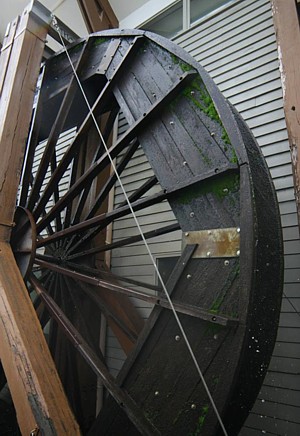Warburton Waterwheel Information - How does a Waterwheel work?
The Warburton Waterwheel is an example of the type of motive power used by the pioneers who mined for gold in Warburton in the early days. See it in at the Warburton Waterwheel open 10am - 4pm daily.
A Waterwheel consists of a wheel mounted on a horizontal shaft, able to rotate on bearings, with containers or "buckets" fixed to the outer rim of the wheel. When filled with water at the top of the wheel, the full buckets on one side of the wheel exceed the weight of the empty buckets on the other side and cause the wheel to rotate. The full buckets spill out water at the bottom of the wheel as it rotates and empty buckets are refilled as they reach the top of the wheel. The power obtained from the revolving wheel can be used to drive machinery such as battery stamps, pumps or other equipment.
The mechanics of operation are interesting as they tell us more about the characteristics of the wheel.
Rotation of the wheel is comparatively slow - about 10 revolutions per minute (RPM) but because of the the large diameter of the wheel, (6 meters), the speed of the outer rim is quite high. (10 x 6x pi x 60/1000 = 11.3km/hr). For safety reasons stand well back from the wheel while it is revolving.

The speed of rotation is dependent upon the amount of water entering the buckets, the friction of the bearings and the amount of work being done on the wheel.
Consider the stationary ("locked rotor") forces acting on the wheel. Each bucket is filled with up to 20 litres of water. At the furtherest point, the bucket is 3m from the axis of rotation and the turning moment is the product of the mass and distance. Other buckets, depending on their position around the wheel, are at lesser distances from the axis and so their turning moment is correspondingly less. The lower buckets are spilling out their water and so have a lesser turning moment due to both a lesser distance and a reduced amount of water. Despite these factors, it would be possible to calculate an overall turning moment due to effect of the water in a locked rotor condition.
But there is another complication. As the wheel begins to turn, the mass of water exerts a lesser force on the bucket. Imagine the wheel to be turning at a speed which approximates the free fall velocity of water (say halfway down the wheel - this can be easily calculated from Newton's v squared formula). At this point, the water would exert zero force on the bottom of the bucket. This then, becomes the limiting speed of the wheel which in this case is 27km/hr or 24 RPM so no matter how much water is poured into the buckets, the ultimate speed of the wheel will not exceed this. The water, incidentally, comes under another force, that of centrifugal force due to rotation but this does not significantly alter the speed.
One way of calculating the power which could be obtained from the wheel is to multiply the quantity of water (20litres x 36 buckets x 10RPM) by the height moved (6 meters) by the pre established efficiency for a waterwheel (about 60%) and convert this to kilowatts or horsepower. The maximum output for this wheel would be approximately 4.5 kW or 6 HP.
So, understanding these mechanics of operation, we can determine that a waterwheel will operate best with water filling the buckets but rotating at a "slow" speed with appropriate gearing or pulley drives to obtain a desired equipment speed which, preferably, should have a steady load.
Information source: Hardcopy information leaflet FILE wheelmec.p65 23.4.98
Do you have a story or history about this place or picture? Send your info to paul@warburtoninfo.com and we will upload. We love to share the stories of people and times gone by in Warburton
|
© Copyright Warburton Information Guide - Site Map Warburton Australia |
